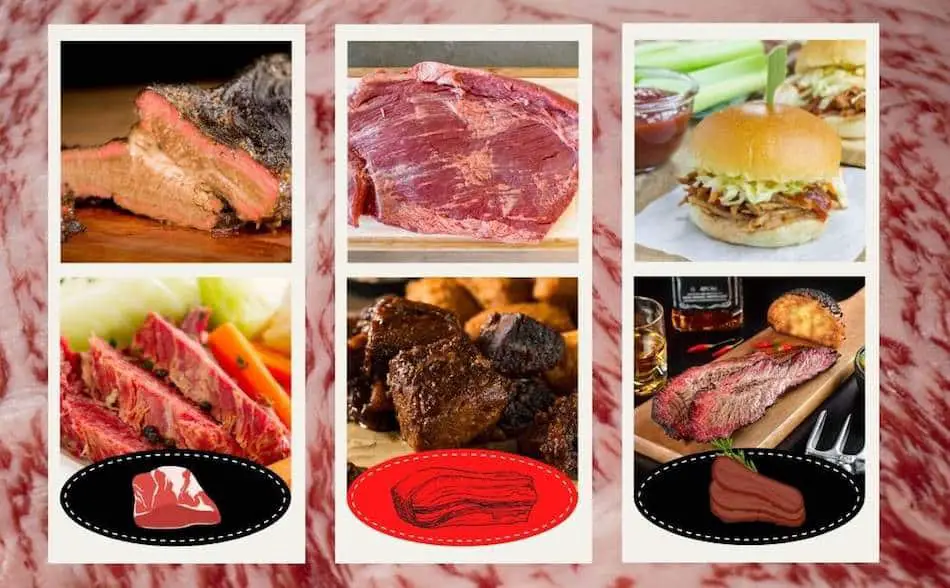
Nowadays, brisket is most famous for being the biggest and best barbecue meat. However, brisket also has many uses in the kitchen. In this article, I’ll show you all the different ways to prepare brisket—including recipes.
The best way to cook brisket is low-and-slow in a smoker, slow cooker or oven. You can either slice the brisket, or shred the meat for pulled beef. Shredded brisket makes delicious sliders and ground brisket offcuts make the best burgers. You can use low grade brisket for corned brisket. The best way to reheat cooked brisket is by using the sous-vide method.
Different Ways To Cook Brisket
Since brisket is a tough cut of meat, so it’s best cooked low-and-slow. Here are the best ways to cook or serve brisket.
- Smoked brisket
- Slow cooked brisket
- Roasted brisket
- Sous-vide brisket
- Shredded/pulled brisket
- Brisket sliders
- Ground brisket burgers
- Corned brisket
- Brisket burnt ends
What Is Brisket?
Brisket is a cut of beef that comes from the four-quarter of the animal. A hard-working muscle, brisket contains a lot of fat and connective tissue—so it needs to be cooked properly. Brisket has several uses, and if prepared correctly, it can be absolutely delicious. Brisket has two muscles; a point and a flat.
The Brisket Point
The largest muscle is the brisket point. The point is an oval-shaped muscle that contains more fat and more connective tissue. The smaller muscle of the brisket is the flat. As its name suggests, it is a flat muscle has a flattened shape, and is much leaner.
The Brisket Flat
The brisket flat needs to be cooked differently to the brisket point. The flat is lean, so it will cook sooner and will dry out if left for too long. If you were to cook a full packer brisket, you’ll find that it will cook unevenly because the flat will be done sooner than the point.
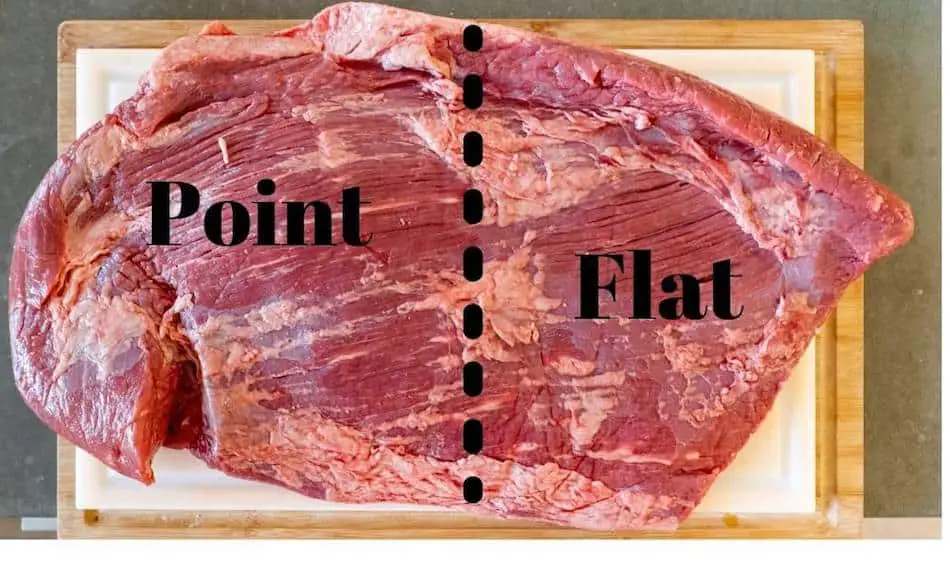
Brisket Must Be Cooked Low-And-Slow
Whatever method you choose, the most important thing to remember is brisket needs time at low temperature in order to be delicious. Brisket is a tough cut of meat, full of connective tissue. The only way to make brisket tender is to cook it slow.
Brisket Needs Time At Low Temps
The USDA recommends brisket be cooked to an internal temperature of 145°F. Although brisket is safe to eat at this temp, it will be too tough to eat. Brisket needs to be taken to around 200°F to be tender. If you cook brisket between 145°F and 190°F, the meat will be chewy. Brisket needs time at low temperatures to break down the connective tissue. This is the same when smoking, roasting or slow cooking.
Have you tried smoking a Wagyu brisket yet? You can get one delivered to your door from Snake River Farms.
The Rub and Seasoning
Prior to cooking, cover the brisket with a barbecue rub. You can buy dry rubs online, or make your own. If you prefer are-made rub, I highly recommend Killer Hogs. The cheaper way is to make your own rub at home. Check out this post: Brisket Rub Recipe. In this article, I’ll show the best dry rub for brisket.
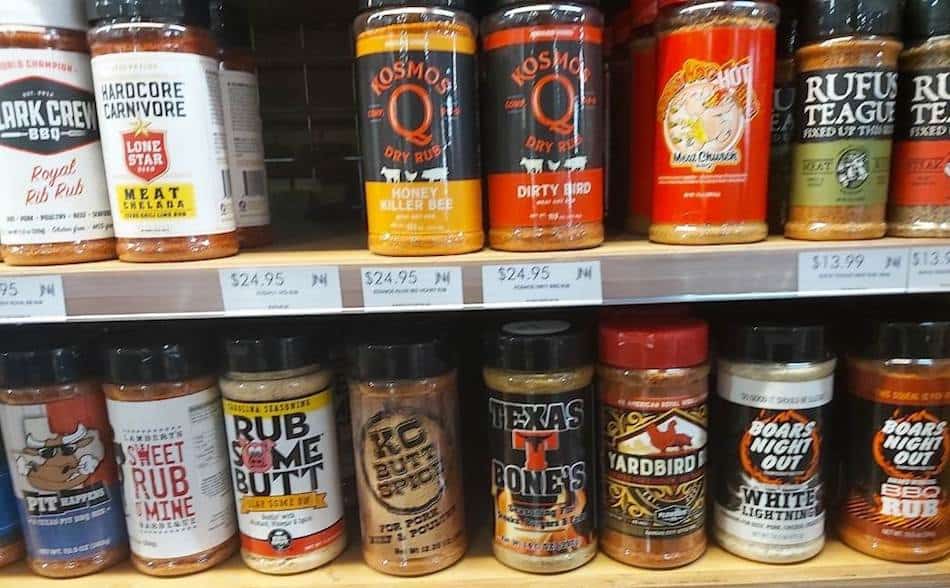
Trimming The Brisket
Before cooking, you need to trim the brisket. Always leave 1/4 an inch of fat on the top of the brisket. This fat will insulate the brisket and help keep the meat moist. If you leave too much fat, it won’t render. So make sure you only leave 1/4 an inch. There’s an enormous chunk of fat called the deckle that sits between the two muscles. Cut out this fat because it won’t render.
Applying A Binder To Brisket
If you want the rub to stick to the brisket, it’s best to apply a binder before the rub. Slather the brisket with olive oil or yellow mustard before applying the dry rub. This will help the rub stick to the meat, which will help you get a nice crispy out of layer called the bark.
The Smoked Brisket
Smoking is by far the best way to cook brisket. Barbecue pitmasters like Aaron Franklin have made an art form of the smoked brisket. Smoked brisket is the central part of the barbecue plate in Texas and the southern states. And thanks to YouTube, brisket has gained worldwide popularity. The low-and-slow cooking trend caused brisket prices to skyrocket.
How To Smoke Brisket
Smoking brisket is easier than it sounds. If you don’t have a smoker or a pellet grill, you can smoke a brisket on a kettle grill. All you need is some charcoal and smoking wood that you can find at your local hardware store. A thermometer is also useful. If you want to know how to get started, check out my Beginner’s Guide To Smoking Meat.
Smoked Brisket

Tender, juicy smoked brisket cooked low and slow on a smoker.
Ingredients
- Brisket
- Barbecue rub
- Kosher salt ( for the dry brine)
- Yellow mustard or olive oil ( for the binder)
Instructions
1. Select a brisket with good marbling.
2. Trim the fat but leave 1/4 inch of fat on top.
3. Dry brine the brisket by sprinkling kosher salt on both sides of the meat and refrigerate for a few hours or overnight.
4. Inject the brisket with broth or marinade. * Optional
5. Slather the brisket with olive oil or yellow mustard. *Optional
6. Apply an even layer barbeque rub. If the rub contains salt, skip the dry brine step.
7. Use hickory, oak, pecan or your favorite smoking wood.
8. Set the temperature of your smoker between 225°F to 250°F
9. Place the brisket in smoker away from the heat source.
10. Fill the water pan with hot water.
11. Insert a leave-in meat thermometer into the brisket.
12. Leave the brisket alone for the first 3 hours or so. Allow the brisket to absorb smoke and develop a bark.
13. Once the rub has fused to the meat, begin to spritz the brisket every hour with either apple juice, broth, apple cider vinegar or beer. Otherwise, mop with a mop sauce.
14. Once the bark is firm, wrap the brisket in foil or butcher paper. By this stage, the meat should have reached an internal temperature between 150°F and 160°F.
15. Insert the thermometer into the meat and place the brisket back in the smoker.
16. Continue cooking until the brisket is tender as butter when poked with a toothpick or probe. The internal meat temperature should read somewhere between 195°F and 203°F when perfectly tender.
17. Allow the meat to rest for about 1 hour before slicing. If you're not ready to serve, place the brisket into a dry cooler. Keep the brisket wrapped in foil or butcher paper, then wrap again with a towel or dish cloth. The brisket will remain hot for over 4 hours. Keep a thermometer probe inserted.
18. Slice against the grain and serve.
Nutrition Information:
Serving Size:
85 gramsAmount Per Serving: Calories: 246 grams
Keep The Temperature Stable
Whatever type of smoker you have, keep the temperature between 225° F and 250° F and maintain for the entire cook. If the temperature fluctuates, it could ruin your brisket. Use a thermometer in your smoker. This will help you keep the smoker in the right range.
Smoking Wood
The best smoking wood for brisket is hickory, pecan or oak. If you prefer something softer, apple or cherry are good choices. If you’re using a charcoal smoker, throw on a few chunks of smoking wood. Wood chips will burn too quickly and should only be used on electric smokers.
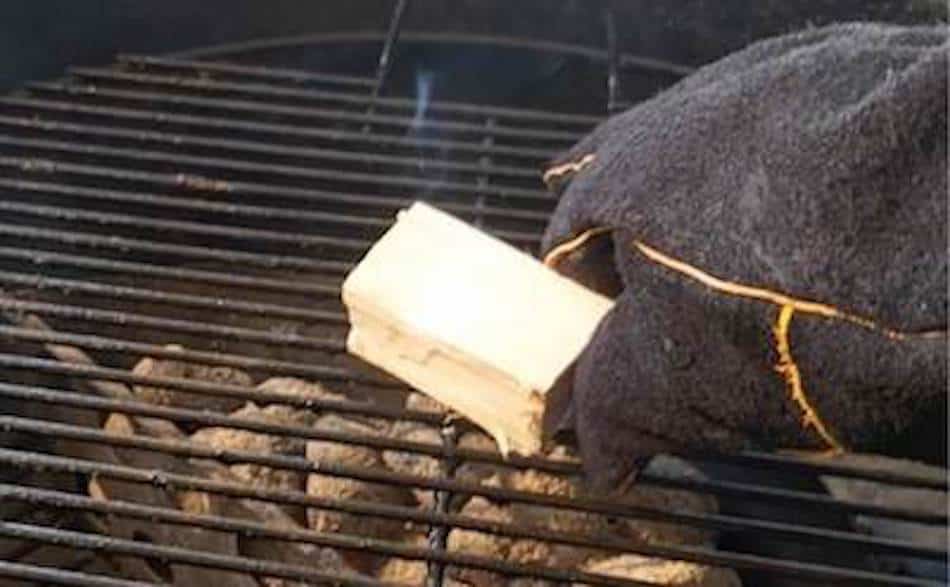
The Cook
- Place the brisket in the smoker and leave for 3 to 4 hours.
- At the halfway point of the cook, the bark should have developed on the brisket. Give the brisket a spritz with a spray bottle using apple cider vinegar or apple juice. Spritzing will prevent the brisket from drying out and stop the edges from charring.
- Once the bark is firm and cracking, wrap the brisket in aluminium foil or butcher paper. Once wrapped, place it back into the smoker for the rest of the cook. Keep a thermometer inserted so you can monitor the internal meat temperature. Cook the brisket until it reaches an internal temperature of a round about 200° F.
Resting The Brisket
When done, remove the brisket and restore at least 1 hour. Resting is extremely important when cooking brisket. If you don’t allow enough resting time, the brisket will dry out. If you’re not ready to slice, place the brisket in a dry cooler where it will stay hot for 4 hours. For more on this, check out this article: Resting Brisket In A Cooler.

Roasted Brisket
One of the most simple ways of cooking brisket is in the oven. No matter what method you use to cook brisket, keep the temperature somewhere between 225°F and 250°F. Prepare the brisket the same way as mentioned above. Apply a binder and rub prior to cooking. Cook until the bark has formed, then wrap the brisket halfway through the cook. Use a meat thermometer, and cook until the brisket reaches a 200° F internal temperature. This may take several hours.
Gordon Ramsey has a fantastic recipe for oven roasted brisket that has a barbecue brisket flavor. If you sear the outside of the brisket first, yo can get a nice crust on the outside.
Brisket In A Slow Cooker (Crock Pot)
Another way to cook brisket is in a slow cooker. A slow cooked brisket won’t have a nice crispy bark, but it will be tender and juicy. The brisket will cook a little faster in a slow cooker when compared to the smoker or the oven. You don’t need to wrap a brisket when cooking in the slow cooker. Set the temperature to low and cook until it reaches an internal temperature of 200° F. It’s difficult to judge how long that will take, because no two briskets are the same.
Brisket Burnt Ends
One of the best brisket recipes is brisket burnt ends. More of a side dish, burnt ends are a barbecue delicacy. To make burnt ends, use the brisket flat and cut it into cubes, or set aside your brisket offcuts. For a full burnt ends recipe, check out this post: Brisket Burnt Ends.

Brisket Burgers
Brisket offcuts can make brisket burgers. Brisket is expensive, so you don’t want to waste an ounce. When trimming a large brisket, you will end up with lots of trimmings. Save all the trimmings and run them through a grinder. Ground brisket makes the tastiest ground beef, and the most amazing burgers! Get into the habit of saving and freezing all your brisket meat and fat trimmings. Once you build up enough, you’ll have enough to make a big batch of brisket burgers.
Save The Brisket Fat
Before making ground brisket, make sure you’ve saved all your brisket fat trimmings. Freeze or vacuum seal the fat, then bring them out when making ground brisket. The fat is where most of the flavor is found. Wagyu brisket is delicious because of the fat. So keep that in mind when making ground brisket.
How To Make Ground Brisket
Collect all your brisket trimmings and place them into a grinder. When mixing the fat and brisket meat, you want a good fat to meat ratio. Aim for 40% fat and 50% meat. Grind the fat and meat separately and place them into two mixing bowels. Combine the ground fat and ground brisket until they are evenly mixed.
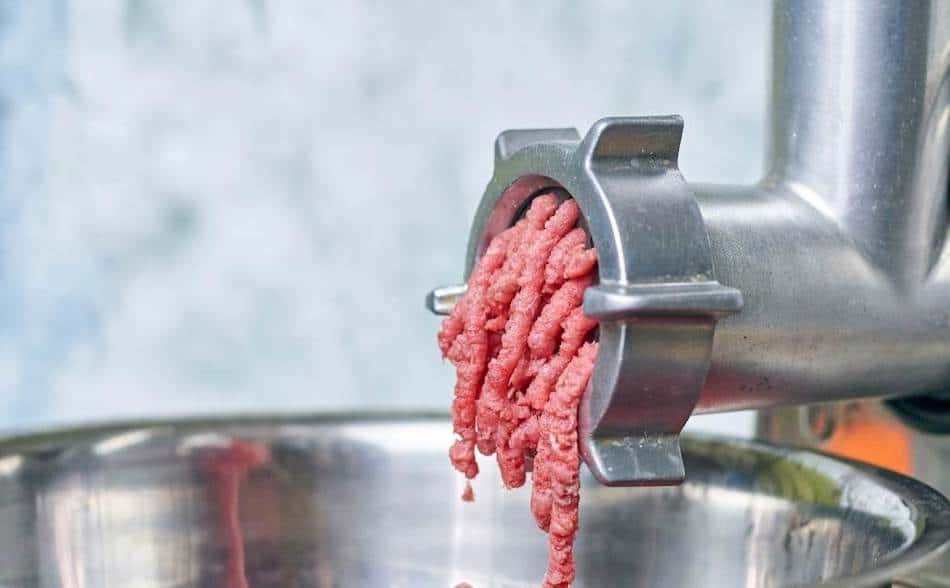
Store Your Brisket Trimmings
Once you have your ground brisket meat and fat combined, roll the meat into large compacted balls. Then squash the balls into patty shapes. Rather than using binders, semi-freeze the burger patties before grilling or smoking.
To do this, place the burgers onto a tray and leave them in the freezer for about an hour. You don’t want to freeze them. You just want them firm. Then remove the burgers from the freezer, and cook. If you have a pellet grill or smoker, ground brisket makes the best smokehouse burgers! Check out the recipe here.
Corned Brisket
Corn brisket or pickled brisket is a popular cold meat found in delis. However, corned brisket is becoming less popular because brisket is now being used for low-and-slow cooking. It’s easy to make corn brisket at home if you know how to make a cure, then soak the brisket in a cure for a few days. Then cook, cool and serve cold in sandwiches. or the best corned beef recipe, head over to Amazing Ribs. They have THE BEST recipe for corned beef. Check it out here.
Shredded Brisket
You can turn your excess brisket into shredded beef. Similar to pulled pork, pulled brisket makes amazing tacos, nachos, or pulled beef sliders. Shredded brisket has an enormous amount of flavor and is a great way to serve brisket leftovers. For a brisket sliders recipe, check out this post I wrote a while back: Brisket Sliders Recipe.
Brisket Sandwich With Coleslaw
In many areas in the South, they traditionally served brisket with coleslaw. To eat brisket this way, make a brisket sandwich and serve it with coleslaw.
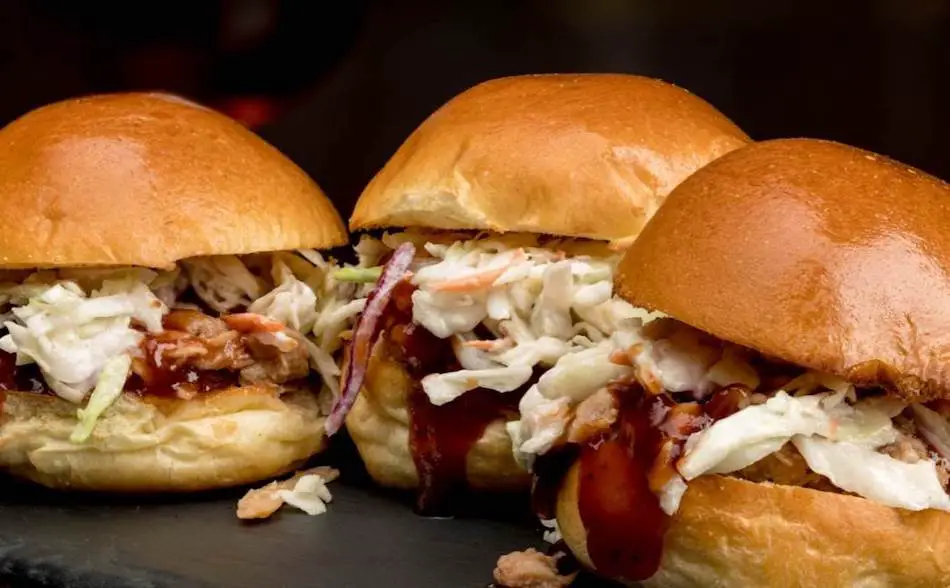
Brisket With Mac And Cheese
If you’re smoking a brisket, cook some mac and cheese alongside your brisket and serve them together. This is another barbecue favorite.
My Favorite Brisket Tools
Thanks for checking out this article. I hope you learned a few things. Here are some of my favorite tools I use when smoking brisket that may be useful to you. These are affiliate links, so if you decide to purchase any of these products, I’ll earn a commission. But in all honesty, these are the tools I recommend to my family and friends who are just starting out.
Meat Injector: Injecting meat is a great way to take your barbecue to the next level and help you make competition-style brisket. An injector is the only way you will be able to get flavor and moisture into the middle of the meat. The Beast Injector is a stainless steel injector that is sturdy and affordable. Check the latest price on Amazon here.
Brisket Marinade: The best injection solution on the market is the Butcher BBQ Brisket Injection. This marinade is used in competitions and is made by World Barbecue Champion pitmaster, Dave Bouska. You can find the marinade on Amazon here.
Butcher Paper: Wrapping brisket in butcher paper has become a huge trend in barbeque thanks to Aaron Franklin. Wrapping your brisket in paper will give you a nice brisket bark. However, you can’t just use any old paper, it has to be unwaxed, food grade paper. You can find it on Amazon here.
Brisket Rub: These days I make my own rub when possible, but I always have a few pre-made rubs for when I’m running low. Barbecue guru Malcom Reed produces Killer Hogs, one of the best brisket rubs I’ve found over the years. Another great rub is Slap Yo Daddy, made by brisket master and multiple World Barbecue Champion, Harry Soo.
Meat Thermometer: There are dozens of fancy thermometers on the market, but I still use my trusty TP20. For around $50, I have a high-quality meat thermometer with two probes, and can track the temperature of my smoker with one probe, and my meat with the other probe. The ThermoPro TP20 is an Amazon Best Seller because it’s the easiest thermometer to operate, is durable, highly accurate, and comes with pre-programmed meat settings.
Instant Read Thermometer: Arguably, the second most important tool you need is a fast and accurate instant-read thermometer. These tools play an important role in the latter stages of the cook when the meat needs regular checking in multiple areas. I use the ThermoPro TP19 because it can do everything a ThermaPen can do, but for a fraction of the cost. You can check out the TP19 on Amazon here.
Advanced Thermometer and Automatic Temperature Controller: Once you’re ready to take things seriously, the FireBoard 2 Drive is a six-channel Bluetooth/Wi-Fi thermometer that can monitor up to 6 pieces of meat, control and graph your cook sessions on your smartphone, and attaches to an an automatic blower that will convert your charcoal smoker to a set-and-forget. This is one of the most advanced meat thermometers on the market. You can check it out on the FireBoard website here.
